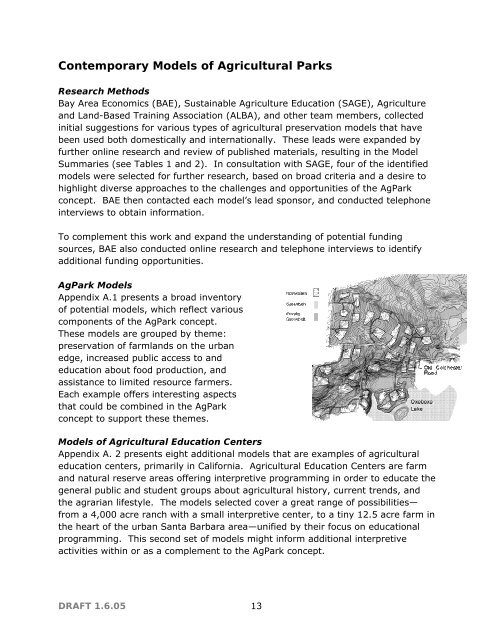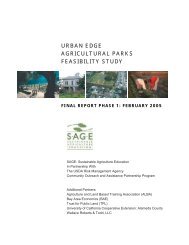elements of sharecropping. This type of arrangement has recently gained greaterprominence in many rural communities across the U.S. as a way <strong>for</strong> limitedresource and immigrant farmers to obtain access to agricultural land.Businesses known as agricultural brokers, grower/shippers, or simply investors,provide <strong>for</strong> a modern day version of sharecropping, in which many inputs andfactors of production, including land, water, seeds, plants, fertilizers, pesticides,markets, distribution channels, among others, are supplied or dictated to thefarmer by the broker, grower/shipper or investor. This type of arrangementattempts to reduce the risks inherent in farming by streamlining the process ofproduction and sale, while at the same time, reducing the degree to which thefarmer participates in decision making.Given the preliminary results of the Land Access Needs Survey, some derivation ofcommunal or collective access and management of agricultural land appears to bean attractive alternative <strong>for</strong> limited resource, small and aspiring farmers to obtainaccess to land. This alternative is being considered in the current context ofastronomical real estate prices, the need to protect agricultural and natural lands,buffer urban growth boundaries, strengthen food security and sovereignty of localcommunities, meet consumer demand <strong>for</strong> local, sustainably produced food, andprovide land access opportunities <strong>for</strong> established and aspiring farmers.DRAFT 1.6.05 12
Contemporary Models of <strong>Agricultural</strong> <strong>Parks</strong>Research MethodsBay Area Economics (BAE), Sustainable Agriculture Education (<strong>SAGE</strong>), Agricultureand Land-Based Training Association (ALBA), and other team members, collectedinitial suggestions <strong>for</strong> various types of agricultural preservation models that havebeen used both domestically and internationally. These leads were expanded byfurther online research and review of published materials, resulting in the ModelSummaries (see Tables 1 and 2). In consultation with <strong>SAGE</strong>, four of the identifiedmodels were selected <strong>for</strong> further research, based on broad criteria and a desire tohighlight diverse approaches to the challenges and opportunities of the AgParkconcept. BAE then contacted each model’s lead sponsor, and conducted telephoneinterviews to obtain in<strong>for</strong>mation.To complement this work and expand the understanding of potential fundingsources, BAE also conducted online research and telephone interviews to identifyadditional funding opportunities.AgPark ModelsAppendix A.1 presents a broad inventoryof potential models, which reflect variouscomponents of the AgPark concept.These models are grouped by theme:preservation of farmlands on the urbanedge, increased public access to andeducation about food production, andassistance to limited resource farmers.Each example offers interesting aspectsthat could be combined in the AgParkconcept to support these themes.Models of <strong>Agricultural</strong> Education CentersAppendix A. 2 presents eight additional models that are examples of agriculturaleducation centers, primarily in Cali<strong>for</strong>nia. <strong>Agricultural</strong> Education Centers are farmand natural reserve areas offering interpretive programming in order to educate thegeneral public and student groups about agricultural history, current trends, andthe agrarian lifestyle. The models selected cover a great range of possibilities—from a 4,000 acre ranch with a small interpretive center, to a tiny 12.5 acre farm inthe heart of the urban Santa Barbara area—unified by their focus on educationalprogramming. This second set of models might in<strong>for</strong>m additional interpretiveactivities within or as a complement to the AgPark concept.DRAFT 1.6.05 13
- Page 1 and 2: DRAFTURBAN EDGEAGRICULTURAL PARKSFE
- Page 3 and 4: EXECUTIVE SUMMARYOverview of AgPark
- Page 5: Farmworker Housing on the Rural/Urb
- Page 10 and 11: seeking to develop effective collab
- Page 12: INTRODUCTIONHistory of Collective F
- Page 17 and 18: accommodations, value-added product
- Page 19 and 20: 45%, from 5,347 in 1997 to 7,771 in
- Page 21 and 22: information about each site include
- Page 23 and 24: undertaken. It may be best to furth
- Page 25 and 26: IDENTIFICATION OF POTENTIAL AGPARK
- Page 27 and 28: SONOMA COUNTYLaguna Farm 80-acre 3
- Page 29 and 30: The above examples reflect a range
- Page 31 and 32: MARTIAL COTTLE PARK FEASIBILITY STU
- Page 33 and 34: Median household income in the neig
- Page 35 and 36: • Relationship to surrounding nei
- Page 37 and 38: • Education/Research Center: 4-H,
- Page 39 and 40: Management and DevelopmentRole of S
- Page 41 and 42: Beyond the capital costs for the in
- Page 43 and 44: ConclusionThis property has great p
- Page 45 and 46: Ardenwood Historic Farm is the rema
- Page 47 and 48: • Establish Ardenwood as a vibran
- Page 49 and 50: These ideas complement and build on
- Page 51 and 52: • Farmer Housing: None proposed.
- Page 53 and 54: ConclusionsThis project identified
- Page 55 and 56: Appendix A: Overview of Ag Park Mod
- Page 57 and 58: The National Trust(England, Wales,N
- Page 59 and 60: Crystal Waters Village(Malaney, pop
- Page 61 and 62: McBryde AgriculturalPark (Kauai, HI
- Page 63 and 64:
Farm worker Housing on Rural/Urban
- Page 65 and 66:
Occidental Arts& EcologyCenter(Occi
- Page 67 and 68:
The FarmSchool (Athol,MA)Privatelyo
- Page 69 and 70:
To ensure conservation in perpetuit
- Page 71 and 72:
King County FarmlandPreservation Pr
- Page 73 and 74:
development.Economics/Sources of Fu
- Page 75 and 76:
In 2001, the Trust advanced a susta
- Page 77 and 78:
LandThe cooperatives have sought la
- Page 79 and 80:
ALBA’s Farm Training andResearch
- Page 81 and 82:
• “ALBA Organics” distributio
- Page 83 and 84:
in addition to herbs, flowers, and
- Page 85 and 86:
APPENDIX C: FUNDING SOURCES FOR AGP
- Page 87 and 88:
Public Support for FarmlandPreserva
- Page 89 and 90:
transactions. Transaction types wil
- Page 91 and 92:
Affordable Rural Housing Grant andL
- Page 93 and 94:
farm" program, established farmers
- Page 95 and 96:
Appendix D: Producer Survey Instrum
- Page 97 and 98:
12. Would you be interested and wil
- Page 99 and 100:
Feasibility Study for Urban Edge Ag
- Page 101:
Site BLocationFremont, adjacent to





